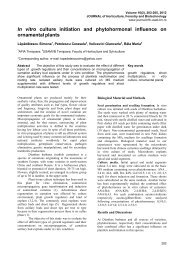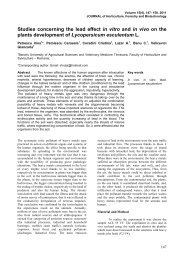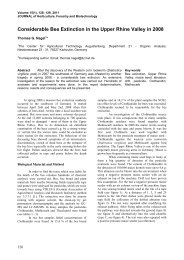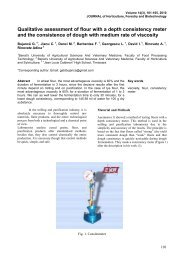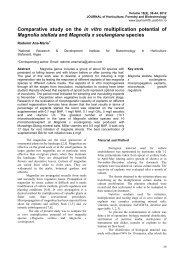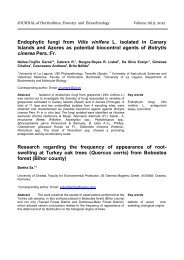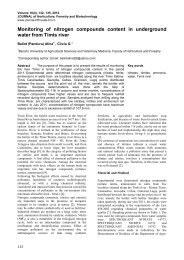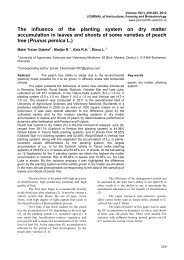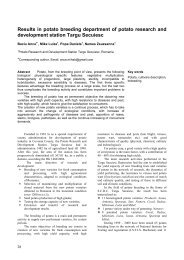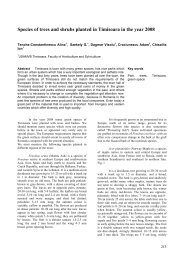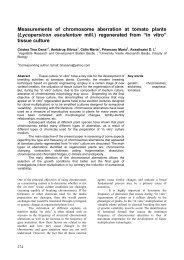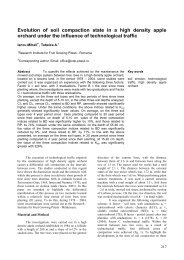(RAPD) markers
(RAPD) markers
(RAPD) markers
You also want an ePaper? Increase the reach of your titles
YUMPU automatically turns print PDFs into web optimized ePapers that Google loves.
In vitro variability of Cymbidium sp. based on random<br />
amplified polymorphic DNA (<strong>RAPD</strong>) <strong>markers</strong><br />
Petolescu Cerasela 1 *, Lazar A. 1<br />
1 USAMVB Timisoara, Faculty of Horticulture and Sylviculture<br />
*Corresponding author. Email: cerapetolescu@yahoo.com<br />
Abstract The objective of this study was to determine in vitro variability<br />
using randomly amplified polymorphic DNA (<strong>RAPD</strong>) <strong>markers</strong>. DNA from<br />
eleven in vitro obtained plantlets of cymbidium was examined using<br />
polymerase chain reaction (PCR) to determine the efficiency of randomly<br />
amplified polymorphic DNA (<strong>RAPD</strong>) <strong>markers</strong> in identifying of somaclonal<br />
variability. We used 4 <strong>RAPD</strong> primers. Concerning <strong>RAPD</strong> analysis, template<br />
DNA produced clear PCR profiles. As a result of UV light screening of<br />
agarose gels, it has been observed slight differences between the genetic<br />
fingerprints of the studied variety induced by amplification using <strong>RAPD</strong> primer.<br />
Key words<br />
Cymbidium, <strong>RAPD</strong>,<br />
somaclonal variation<br />
Cymbidium is one of the Orchidaceae genera.<br />
There are 70 Cymbidium species in the world, mainly<br />
distributed over the tropical and the subtropical area of<br />
Asia and northern Australia. The genus Cymbidium<br />
(Orchidaceae) comprise species distributed from<br />
Northwest India to China and Japan, south through the<br />
Malay Archipelago to North and East Australia.<br />
Cymbidiums have been, for over one hundred years,<br />
and remain at the present day the most important<br />
orchid in commerce, being primarily grown for their<br />
flowers which are attractive, long lasting and large.<br />
They are increasingly gaining popularity as decorative<br />
pot plants with smaller, but equally high quality<br />
flowers. Most of the commercially important, large<br />
flowered cymbidiums in cultivation are hybrids derived<br />
from the 44 recognised species. These modern hybrids<br />
are often complex, involving several species in their<br />
ancestry.<br />
Classical approaches for the identification of<br />
cymbidium cultivars are based on morphological traits.<br />
The assessment of these traits is difficult and their<br />
evaluation can be subjective considering that most of<br />
these cultivars are related.<br />
Many cultivars have been selected and used;<br />
however, their genetic background was unknown.<br />
Genetic diversity has been studied in plant species<br />
using a variety of morphological, chemical and<br />
molecular descriptors.<br />
The random amplified polymorphic DNA<br />
technique (Welsh J and McClelland M (1990),<br />
Williams et al., 1990) based on the polymerase chain<br />
reaction (PCR) has been used for in vitro variability<br />
identification and or genetic diversity studies in roses<br />
peach, tea, cymbidium [9,10,11] and annanas. The<br />
<strong>RAPD</strong> technique has also been used to determine the<br />
purity of hybrid seed in tomato.<br />
Molecular <strong>markers</strong> and molecular sequences<br />
contain useful information about evolutionary<br />
history.[8,12].Recently, the use of random amplified<br />
polymorphic DNAs (<strong>RAPD</strong>s) has become popular. The<br />
arbitrarily primed polymerase chain reaction (or<br />
<strong>RAPD</strong>) amplifies anonymous fragments of DNA from<br />
any genome [2,3]. The size distribution of amplified<br />
fragments varies among species. However, closely<br />
related species have similar fragment distribution,<br />
while distantly related ones are more divergent[4]<br />
Thus, <strong>RAPD</strong> bands (fragments) distribution contain<br />
considerable phylogenetic information[5,6].<br />
Biological Material and Method<br />
The biological material used in this study was<br />
represented by cymbidium plantlets obtained in vitro<br />
culture. Culture media that have generated best results<br />
was a variant of Murashige-Skoog media[1] added<br />
with an auxin, α-naphthalene acetic acid (2 mg/l) and a<br />
cytokinin, 6-benzylaminopurine (1,5mg/l). Resulting<br />
plantlets were tested for genetic variability and<br />
somaclonal variation using <strong>RAPD</strong> analysis.<br />
We used four <strong>RAPD</strong> primers (G04, G10, G17, G18)<br />
with following sequences: 5’AGCGTGTCTT 3’ 5’<br />
AGGGCCGTCT 3’, 5’ ACGACCGACA 3',<br />
5’GGCTCATGTG 3’. Total genomic DNA was<br />
extracted from each plantlets leaf tissues using a<br />
modified CTAB method. DNA samples were diluted in<br />
TE buffer and submitted to electrophoresis (3V cm-1)<br />
in 0.7% agarose gels (w/v). DNA was stained by gel<br />
immersion into ethidium bromide solution for 30 min.<br />
<strong>RAPD</strong> reactions were performed in a final volume of<br />
25 µl in PCR buffer containing MgCl2, <strong>RAPD</strong> primers,<br />
dNTP, DNA template and Taq DNA polymerase.<br />
475
Reactions were submitted to the following PCR<br />
program: preliminary DNA denaturation for 3 min at<br />
94°C, followed by 45 cycles consisting of denaturation<br />
(3 min, 94°C), primer annealing (1,5 min, 36°C), and<br />
extension (2 min, 72°C). A final extension for 2 min at<br />
72°C was included. The <strong>RAPD</strong> products were<br />
separated by electrophoresis (3V cm-1) in 2% agarose<br />
gels, which run with 1 x TAE buffer. Photo<br />
documentation was performed under UV light using a<br />
photo imaging system.<br />
Results and Discussions<br />
This research wants to show, if in this case, it<br />
induced somaclonal variation.The frequency of the<br />
<strong>RAPD</strong> fragments was estimated for each individual.<br />
The total number of clear bands obtained from each<br />
primer ranged from 2 (G03) to 7 (G10).<br />
Concerning <strong>RAPD</strong> analysis, template DNA<br />
produced clear PCR profiles. As a result of UV light<br />
screening of agarose gel, it has not been observed<br />
differences between the genetic fingerprints of the<br />
studied variety induced by amplification using GO4,<br />
G17, G18 primers. The amplification using G10<br />
primers show some differences, emphasizing slight<br />
polymorphism at molecular level. We can see a gel<br />
with a size marker on the left (M) and 12 individuals<br />
analyzed with G10 primer. The size of bands varied<br />
from 1000 bp-300 bp. It can be observed a slight<br />
polymorphism at molecular level. Six individuals<br />
present differences, it identify the presence a band by<br />
400 bp. It can be observed that are differences<br />
comparing with the mother-plant.<br />
M mt 1 2 3 4 5 6 7 8 9 10 11<br />
Figure 1. <strong>RAPD</strong> patterns generated by primer G10<br />
Legend: M – PCR marker ( 700, 500, 400, 300, 200, 150, 100, 75, 50, 25 bp);<br />
mt - mother plant; lanes 1- 11in vitro regenerated plants<br />
M mt 1 2 3 4 5 6 7 8 9 10 11<br />
Figure 2. <strong>RAPD</strong> patterns generated by primer G18<br />
Legend: M – PCR marker ( 700, 500, 400, 300, 200, 150, 100, 75, 50, 25 bp);<br />
mt - mother plant; lanes 1- 11in vitro regenerated plants<br />
We can see a gel with a size marker on the left<br />
(M) and 12 individuals analyzed with G18 primer. The<br />
size of bands varied from 500 bp-195 bp. It it has not<br />
been observed polymorphism at molecular level.<br />
It can be observed that are not differences<br />
comparing with the mother-plant.<br />
We can see a gel with a size marker on the left<br />
(M) and 12 individuals analyzed with G17 primer. The<br />
size of bands varied from 550 bp-500 bp. It has not<br />
been observed polymorphism at molecular level. It can<br />
be observed that are not differences comparing with the<br />
mother-plant.<br />
476
M mt 1 2 3 4 5 6 7 8 9 10 11<br />
Figure 3. <strong>RAPD</strong> patterns generated by primer G17<br />
Legend: M – PCR marker ( 700, 500, 400, 300, 200, 150, 100, 75, 50, 25 bp);<br />
mt - mother plant; lanes 1- 11in vitro regenerated plants<br />
Conclusions<br />
Data presented and discussed in this study<br />
represent a first step for the next studies concerning the<br />
efficiency of randomly amplified polymorphic DNA<br />
(<strong>RAPD</strong>) <strong>markers</strong> in identifying of somaclonal<br />
variability of cymbidium. In the future study we will<br />
study more plants and we use more <strong>RAPD</strong> primers. Ex<br />
vitro Cymbidium plantlet genetic stability will be also<br />
tested and compared.<br />
The evaluation of somaclonal variability of<br />
cymbidium using <strong>RAPD</strong> <strong>markers</strong> alloed to draw the<br />
following conclusions:<br />
- It has not been observed differences between<br />
the genetic fingerprints of the studied variety<br />
induced by amplification using GO4, G17,<br />
G18 primers. It can be observed that are not<br />
differences comparing with the mother-plant<br />
- The amplification using G10 primers show<br />
some differences, emphasizing slight<br />
polymorphism at molecular level.<br />
References<br />
1. Murashige, T.; Skoog, F. A revised medium<br />
for rapid growth and bioassays with tobacco<br />
tissue cultures. 1962. Physiologia Plantarum,<br />
v.15, p.473-497.<br />
2. Williams, J.G., Kubelik, A.R., Livak, K.J.,<br />
Rafalski, J.A., Tingey, S.V., 1990, DNA<br />
polymorphisms amplified by arbitrary primers<br />
are useful as genetic <strong>markers</strong>, Nucleic Acids<br />
Research 18, pag. 6531-6535<br />
3. Welsh J and McClelland M (1990)<br />
Fingerprinting genomes using PCR with<br />
arbitrary primers. Nucleic Acids Res 18,<br />
7213-8.<br />
4. Wilkie SE Isaak PG and Slater RJ (1993)<br />
Random amplified polymorphic DNA<br />
(<strong>RAPD</strong>) <strong>markers</strong> for genetic analysis in<br />
Allium. Theor App Genet 56, 497-504.<br />
5. Campos LP Raelson JV and Grant WF (1994)<br />
Genome relationship among Lotus species<br />
based on random amplified polymorphic DNA<br />
(<strong>RAPD</strong>) Theor Appl Genet 88, 417-22<br />
6. Charmet G Ravel C and Balfourier F (1997)<br />
Phylogenetic analysis in the Festuca-Lolium<br />
complex using molecular <strong>markers</strong> and ITS<br />
rDNA. Theor Appl Genet 94, 1038-46.<br />
7. Prathepha P and Baimai V (1999b) Genetic<br />
differentiation in Thai populations of the rare<br />
species Afgekia serica Craib (Leguminosae)<br />
revealed by <strong>RAPD</strong>-PCR assays. Genetica 105,<br />
193-202.<br />
8. Clegg MT (1993) Chloroplast gene sequences<br />
and the study of plant evolution. Proc Natl<br />
Acad Sci USA 90, 363-7.<br />
9. P. ObaraOkeyo & S. Kako (1998.) Genetic<br />
diversity and identification of cymbidium<br />
cultivars as measured by random amplified<br />
polymorphic DNA (<strong>RAPD</strong>) Euphytica 99: 95–<br />
101<br />
10. Genfa Zhu, Dongmei Li, Qingsheng Ye,<br />
Zhenfei Guo (2006)The relationships among<br />
cymbidium sinense cultivars based on rapd<br />
analysis Acta Horticulturae 766: XXVII<br />
International Horticultural Congress - IHC:<br />
International Symposium on Ornamentals.<br />
11. Choi S. H. ,Kim M. J. ,Lee J. S. ,Ryu K. H<br />
(2006)Genetic diversity and phylogenetic<br />
relationships among and within species of<br />
oriental cymbidiums based on <strong>RAPD</strong> analysis.<br />
Scientia horticulturae ISSN 0304-4238,<br />
vol. 108, no1, pp. 79-85.<br />
12. Haymer DS (1994) Random amplified<br />
polymorphic DNAs and microsatellites: What<br />
are they, and can they tell us anything we<br />
don’t already know Ann Entomol Soc Am 87,<br />
717-22.<br />
477
478



